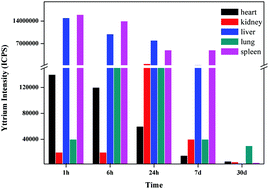当前位置:
X-MOL 学术
›
Metallomics
›
论文详情
Our official English website, www.x-mol.net, welcomes your feedback! (Note: you will need to create a separate account there.)
Elemental bio-imaging of PEGylated NaYF4:Yb/Tm/Gd upconversion nanoparticles in mice by laser ablation inductively coupled plasma mass spectrometry to study toxic side effects on the spleen, liver and kidneys
Metallomics ( IF 3.4 ) Pub Date : 2017-07-12 00:00:00 , DOI: 10.1039/c7mt00132k Qing Li 1, 2, 3, 4 , Zheng Wang 1, 2, 3, 4 , Yirui Chen 1, 2, 3, 4 , Guoxia Zhang 1, 2, 3, 4
Metallomics ( IF 3.4 ) Pub Date : 2017-07-12 00:00:00 , DOI: 10.1039/c7mt00132k Qing Li 1, 2, 3, 4 , Zheng Wang 1, 2, 3, 4 , Yirui Chen 1, 2, 3, 4 , Guoxia Zhang 1, 2, 3, 4
Affiliation

|
Rare-earth upconversion nanoparticles (UCNPs) are considered stable nanoprobes with low toxicity and deep tissue penetration. However, the increasing use of UCNPs has raised concerns about their potential toxicity in living organisms. Very few studies have reported the toxicity of UCNPs; hence, it is not possible to conclude yet that UCNPs are safe. In this study, the distribution of PEGylated NaYF4:Yb/Tm/Gd nanoparticles (PEG-UCNPs) in female Balb/c mice following intravenous administration, and imaging in the spleen, liver and kidney was examined by laser ablation inductively coupled plasma mass spectrometry (LA-ICP-MS). PEG-UCNPs distributed primarily to the liver and spleen, with significant but lower levels being noted in the kidneys, heart, and lungs. At the sub-organ level, PEG-UCNPs mainly accumulated within the red pulp of the spleen instead of the white pulp, which indicated that PEG-UCNPs are poorly immunogenic, or not immunogenic at all. The imaging of Cu in the liver and spleen showed that the primary clearance organ for PEG-UCNPs is the liver, although they are accumulated in the spleen rather than the liver. This can be explained by the fact that excess superoxide anions produced by phagocytosis of the PEG-UCNPs need Cu–Zn-superoxide dismutase to be converted to hydrogen peroxide. From the Fe, Cu, and Zn imaging of the kidney, it was concluded that PEG-UCNPs do not exhibit nephrotoxicity.
中文翻译:

激光消融电感耦合等离子体质谱法对小鼠PEG化NaYF 4:Yb / Tm / Gd上转换纳米粒子的元素生物成像,研究其对脾脏,肝脏和肾脏的毒副作用
稀土上转换纳米粒子(UCNPs)被认为是稳定的纳米探针,具有低毒性和深层组织穿透性。但是,越来越多的UCNPs使用引起了人们对其在生物体中潜在毒性的担忧。很少有研究报道UCNPs的毒性。因此,尚不可能得出UCNP安全的结论。在这项研究中,聚乙二醇化的NaYF 4的分布静脉内给药后,在雌性Balb / c小鼠中使用:Yb / Tm / Gd纳米颗粒(PEG-UCNPs),并通过激光消融电感耦合等离子体质谱法(LA-ICP-MS)检查了脾脏,肝脏和肾脏的成像。PEG-UCNPs主要分布于肝脏和脾脏,在肾脏,心脏和肺脏中的含量明显但较低。在亚器官水平上,PEG-UCNPs主要在脾脏的红色纸浆而不是白色纸浆中积累,这表明PEG-UCNPs的免疫原性很差,或者根本没有免疫原性。肝脏和脾脏中的Cu成像表明,PEG-UCNPs的主要清除器官是肝脏,尽管它们是在脾脏而不是肝脏中积累的。吞噬PEG-UCNPs产生的过量超氧阴离子需要Cu-Zn-超氧化物歧化酶转化为过氧化氢这一事实可以解释。从肾脏的Fe,Cu和Zn成像可以得出结论,PEG-UCNPs不表现出肾毒性。
更新日期:2017-08-03
中文翻译:

激光消融电感耦合等离子体质谱法对小鼠PEG化NaYF 4:Yb / Tm / Gd上转换纳米粒子的元素生物成像,研究其对脾脏,肝脏和肾脏的毒副作用
稀土上转换纳米粒子(UCNPs)被认为是稳定的纳米探针,具有低毒性和深层组织穿透性。但是,越来越多的UCNPs使用引起了人们对其在生物体中潜在毒性的担忧。很少有研究报道UCNPs的毒性。因此,尚不可能得出UCNP安全的结论。在这项研究中,聚乙二醇化的NaYF 4的分布静脉内给药后,在雌性Balb / c小鼠中使用:Yb / Tm / Gd纳米颗粒(PEG-UCNPs),并通过激光消融电感耦合等离子体质谱法(LA-ICP-MS)检查了脾脏,肝脏和肾脏的成像。PEG-UCNPs主要分布于肝脏和脾脏,在肾脏,心脏和肺脏中的含量明显但较低。在亚器官水平上,PEG-UCNPs主要在脾脏的红色纸浆而不是白色纸浆中积累,这表明PEG-UCNPs的免疫原性很差,或者根本没有免疫原性。肝脏和脾脏中的Cu成像表明,PEG-UCNPs的主要清除器官是肝脏,尽管它们是在脾脏而不是肝脏中积累的。吞噬PEG-UCNPs产生的过量超氧阴离子需要Cu-Zn-超氧化物歧化酶转化为过氧化氢这一事实可以解释。从肾脏的Fe,Cu和Zn成像可以得出结论,PEG-UCNPs不表现出肾毒性。


























 京公网安备 11010802027423号
京公网安备 11010802027423号